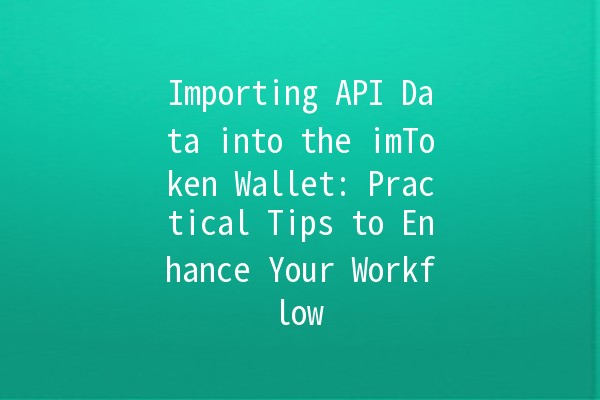In today’s digital economy, managing cryptocurrency efficiently is crucial for both individual users and businesses. One powerful tool that can assist users in this journey is the imToken wallet, which offers robust functionalities through its API. Importing data into the imToken wallet can enhance your experience, enabling effective asset management and transactions. Below, we delve into various techniques for importing API data effectively along with practical tips to optimize your workflow.
API (Application Programming Interface) data import allows users to connect different applications and services, streamlining processes and enabling realtime updates. For cryptocurrency wallets like imToken, utilizing APIs can lead to better management of digital assets and enhanced user experience. The significance of API data import includes:
Understanding these advantages lays the groundwork for exploring the techniques that can streamline your data import processes.

Batch processing is a technique where multiple transactions or requests are processed simultaneously, which can significantly speed up the data importation process.
For example, if you are transferring transaction history from an exchange to your imToken wallet, rather than importing each transaction individually, you can compile them into a single batch. Most APIs allow for this functionality; check the documentation of the API you are using to see how to format these requests correctly.
Webhooks are userdefined HTTP callbacks that can be triggered by specific events. They allow your imToken wallet to receive updates as they happen.
Suppose you're trading across multiple platforms. You could set up webhooks to update your wallet instantaneously with any new transactions made on those platforms. This means that every time a transaction is made, the data is sent to your wallet without requiring you to refresh or manually import the data.
When dealing with API integrations, errors are inevitable. Implementing a robust error handling and logging mechanism can save you a lot of time.
If your API request fails, you should have a way to capture the error details instead of losing the entire import process. By logging errors, you can review what went wrong, troubleshoot, and retry failed transactions without starting the whole process from scratch.
Sometimes, the data format from APIs may not directly fit into your imToken wallet. Using transformation tools can help bridge this gap.
Assume you receive transaction data in a CSV format. To import it into your imToken wallet, you may need to convert it into JSON or another format the API supports. Tools like Apache NiFi or Talend can help automate this transformation process, ensuring smooth data flows.
APIs come with usage limitations (rate limits) and performance metrics that, if not monitored, can hinder your data import process.
If your project relies heavily on API calls for importing data into your imToken wallet, it is crucial to monitor how many requests you make in a given timeframe. Many API providers offer dashboards to track usage. By proactively managing your API calls, you can avoid hitting limitations that would stop your import process.
The imToken wallet is a popular cryptocurrency wallet that allows users to store, manage, and transfer multiple digital assets. It supports a variety of tokens on the Ethereum and other blockchains. Its API integrations facilitate seamless data import, enhancing user experience and providing realtime asset management.
To access the imToken wallet API, you need to register as a developer on the imToken platform and receive your API keys. This will allow you to authenticate your requests and access various endpoints provided by the API.
If you encounter errors, first review the error messages to troubleshoot the issue. Check your API request formats, ensure you're adhering to rate limits, and investigate whether the data you are importing is in the expected format. Logs can be valuable for diagnosing problems with previous imports.
Yes, you can automate the data import process by using scripts that send API requests at scheduled intervals. Tools like cron jobs or task schedulers can help you run these scripts to regularly pull data without manual intervention.
Absolutely. Always use HTTPS for your API requests to ensure encrypted communication. Additionally, regularly rotate your API keys, limit permissions on your keys, and implement OAuth where possible for enhanced security.
To ensure efficiency, organize your imports by batching requests, utilize asynchronous processing to manage multiple requests at once, monitor performance with logging mechanisms, and stay updated with your API’s usage policies to prevent overage.
Successfully importing data into your imToken wallet can open up a streamlined pathway for managing cryptocurrency investments effectively. By adopting these practical tips and understanding the importance of ongoing management and monitoring, you can greatly enhance your productivity and ensure the security and accuracy of your digital assets.
The implementation of these techniques will not only create a more efficient workflow but also empower you with the tools needed to navigate the complex world of cryptocurrency management confidently.